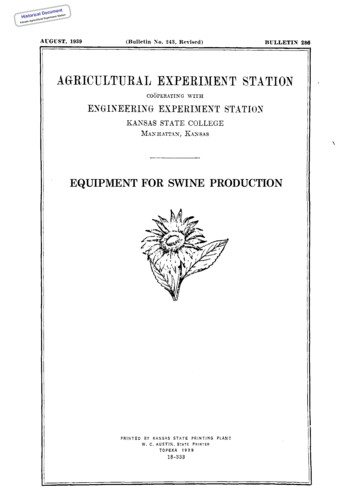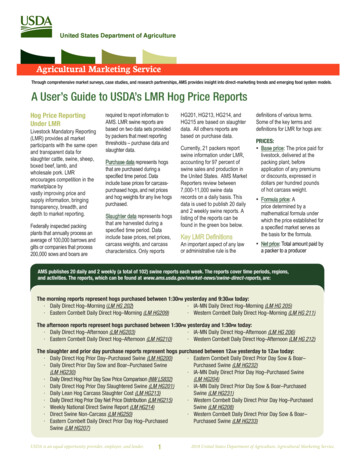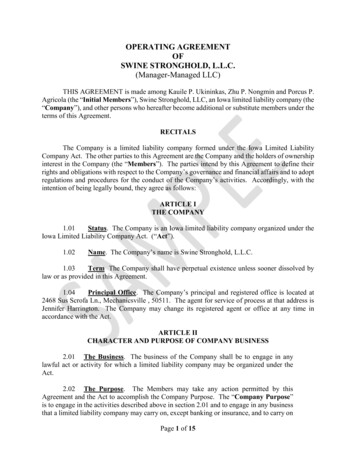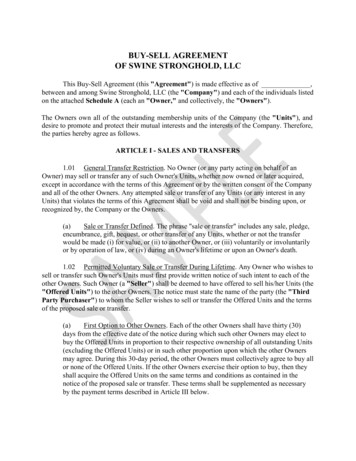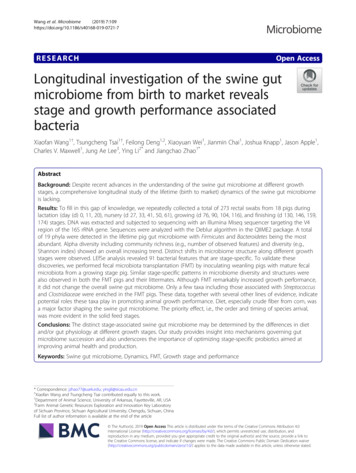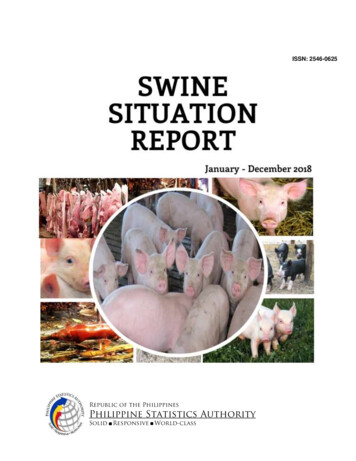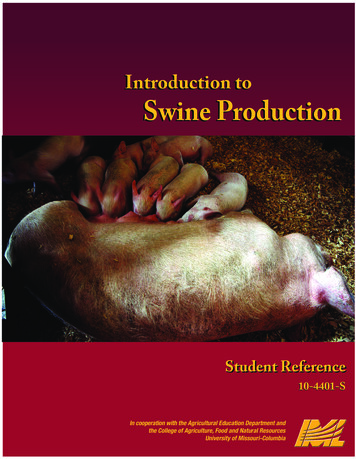
Transcription
Introduction toSwine ProductionStudent Reference10-4401-SIn cooperation with the Agricultural Education Department andthe College of Agriculture, Food and Natural ResourcesUniversity of Missouri-Columbia
Introduction to the Swine IndustryThe swine industry has a major economic impact onSwine Termsagriculture in Missouri. This unit will focus on swineproduction and the important issues facing the industry.The swine industry uses many unique terms. Anyoneinvolved in the swine industry should know andunderstand these terms.Economic ImplicationsFarrow - To give birthThe swine industry has experienced tremendous change.In 2005, more than 105 million hogs were processedinto more than 21 billion pounds of pork. In 1995, morethan 200,000 swine producers operated nationwide. Theindustry has seen a dramatic drop with around 67,000swine producers operating today. The swine industrygenerally ranks either fourth or fifth annually among allproduction agriculture industries in terms of farm cashreceipts. Each year, producers sell more than 11 billionworth of hogs, which have a retail value of 30 billion.Gilt - A young female pig that has not yet farrowedBarrow - A castrated male pigBoar - A male pig used for breedingSow - A mature female hogFeeder pig - A gilt or barrow between weaning andfinishingIn 2005, Missouri had approximately three percent ofhog operations nationwide. The state ranks seventh inthe number of hogs and pigs produced. The top threecounties in the state are Mercer, Sullivan, and Putnam,with close to one million head of hogs between them.Hog numbers in Missouri are illustrated in Figure 1.1.Market hog - A gilt or barrow weighing between 240 and270 pounds and ready for processingFigure 1.1 - Top Three Hog-Producing Counties in Missouri1
Introduction to Swine Productionand sows are mated to boars or artificially inseminated.Females farrow a litter of pigs. The piglets are weaned,and the sows are bred again. The baby pigs are moved intoa nursery until they weigh approximately 50 pounds andthen to a finishing barn where they grow until they reach240 to 270 pounds. The pigs are then sold as markethogs to provide pork for human consumption. Farrowto-finish production is the most intensive productionsystem and generally has the greatest requirements as tomanagement skills, labor, and facilities.Swine FactsBody Temperature - 102.5 FMarket weight - 253 lbs.Avg. age at 250 lbs. - 170 daysPigs per litter - 8.3 weaned nationallyFeed to gain ration - 3 lbs. of feed:1 lb. of gainEvolution of the Swine IndustryThe trend in the swine industry in the United States isFeeder pig production involves producing pigs to sellto other producers to be fed for market. Feeder pigproducers have a herd of sows for breeding. Pigs aresold when they weigh approximately 50 pounds. Theinvestment required for the operation is less than that forfarrow-to-finish production. Most feeder pig producersin Missouri have a contract to produce pigs for a companyinvolved in commercial swine production. The companythen buys the pigs and sends them to feeder pig finishers,who are also under contract.The location of the swine industry is also shifting. Duringthe 1960s and 1970s, most swine production was centeredin the Corn Belt states, such as Iowa, Minnesota, Illinois,Indiana, Nebraska, and Missouri. While these states stillcontain most of the hogs produced in the United States,North Carolina, Arkansas, Texas, Kansas, and Oklahomahave seen tremendous growth in hog numbers. Largecorporate expansions have accounted for much of thisrecent growth.Feeder pig finishers purchase or receive pigs atapproximately 50 pounds. They feed the pigs until theyreach a market weight of 240 to 270 pounds. After theanimal reaches market weight, the pig is processed intosaleable pork and pork products. This system requiresless labor and managerial ability than the other systems.The investment required is also lower than in farrow-tofinish or feeder pig production.toward fewer producers and larger operations. Whilethere are more than 67,000 swine producers operating inthe United States today, there were approximately threemillion producers raising hogs 40 years ago. Thirty yearsago, many swine producers operated farms with less than100 sows. Currently, the industry is moving towardlarger operations. These operations may range in sizefrom 1,000 to 80,000 sows.Business StructuresToday, a major focus of American swine producers isto expand pork exports. The export market enhancesthe economic returns of all swine producers. Theswine industry slogan, “Pork, the other white meat,” isaimed at influencing consumers worldwide to increaseconsumption of pork and pork products.Before the current increase in corporate production, thevast majority of hogs were produced on privately ownedfamily farms. Many family producers still raise hogsindividually.Some producers are involved in network production. Inthis type of production, a group of producers cooperatesto decrease production costs and improve profits for eachoperation. Networking can involve collective marketingarrangements, purchasing supplies at a discount formember operations, or cooperative production of swine.For example, one producer might raise feeder pigs to befinished by another producer in the network.Production SystemsThe major production systems of the swine industry arefarrow-to-finish production, feeder pig production, andfeeder pig finishing.Farrow-to-finish swine production is the most commontype of production. It covers the entire productionprocess, from breeding to sales of market hogs. Gilts2
Introduction to the Swine IndustrySome producers operate on a contract basis. Theindividual producer signs a contract to produce pigs fora company. The company owns the pigs and financesthe operation, and the producer provides the facilities,equipment, and labor. The company makes many of thedecisions about how the pigs are managed. The producerreceives a fixed price per animal.SummaryThe swine industry is an important part of agriculturalproduction in the United States, accounting for over 11billion in farm receipts annually. Swine are producedin farrow-to-finish, feeder pig, and feeder pig finishingproduction systems. The swine industry is changing, withhogs being produced on larger farms at diverse locationsnationwide. Corporate swine production is becomingmore prevalent in the industry. Due to the diversity of theindustry, young people interested in working with swinehave a variety of career opportunities open to them.Many corporate investors have expanded theirinvolvement in the swine industry. The goal of corporatefarms is efficient production of a uniform product.Corporate farms are large-scale operations. They mayalso be vertically-integrated, meaning the company ownsand controls all phases of the production process. Forexample, Company A might own complete farrow-tofinish production facilities, a feed mill that produces feedfor its farms, and a processing plant.CreditsBaker, Meelee, and Robert E. Mikesell. Animal ScienceBiology and Technology. Danville, Ill.: Interstate Publishers,Inc., 1996.Career OpportunitiesGillespie, James R. Modern Livestock and Poultry Production.5th ed. Albany: Delmar, 1997.With the wide scope of the swine industry, careerpossibilities are extremely diverse. Estimates suggest thatover 700,000 jobs in the United States are linked to theswine industry.Harper, Allen F.“The Role of Swine Producer‘NETWORKS.’” gopher://gopher.ext.vt.edu:70/00/.docs/aps/aps-628 (30 July 1997).Many career opportunities exist in the swine industrybesides becoming a producer involved in one of thedifferent production systems. Swine operations needemployees to fill positions, such as breeding manager,farrowing manager, and nursery manager. These positionsinvolve overseeing these activities for the operation. Afeed mill technician is responsible for producing feedfor swine herds. An artificial insemination technicianbreeds sows and gilts using artificial insemination. Animalgeneticists specialize in genetic research to developmore powerful medications and genetically superioranimals. Animal health product sales representativesprovide swine medications and other products to farmstores, veterinarians, and producers. Veterinarians oftenspecialize in swine where large concentrations of hogs arefound. Hog buyers buy market hogs to be processed intopork. USDA inspectors and quality control supervisorswork in pork processing plants to help ensure that thefood supply is safe and wholesome.Lawrence, John D., et al. “Producing and Marketing HogsUnder Contract.” http://www.public.iastate.edu/ pigmap/PIH/6.txt (30 July 1997).Lee, Jasper S., et al. Introduction to Livestock and PoultryProduction. Danville, Ill.: Interstate Publishers, Inc., 1996.Nix, Jackie. “Facts about Contract Livestock contract.html (30 July1997).Taylor, Robert E., and Ralph Bogart. Scientific Farm AnimalProduction. 3rd ed. New York: Macmillan Publishing,1988.Pork Issues Handbook. Des Moines: National PorkProducers Council, 1996/1997.3
Breeds of SwineSuccess in the swine industry depends partly on a broadPietrain - Pietrains are generally spotted with erect ears.They are the leanest and most heavily muscled hogs in theworld. Pietrains often carry a stress gene linked to meatquality problems; the gene causes light-colored, waterypork. They are typically crossed with other breeds toproduce terminal sires (boars used to produce markethogs of which none are kept as replacement breedingstock). Pietrains were imported from Germany andPoland.knowledge of the breeds of hogs used in production.Knowing the different breeds and their characteristics isimportant in making decisions about which breed to usein breeding programs. Producers also need to considerwhether to use hybrid hogs in their operation.Breeds of SwineThe major breeds of swine include the Berkshire, ChesterWhite, Duroc, Hampshire, Landrace, Pietrain, Poland,Spotted, and Yorkshire. Differences between these breedsare apparent in ear type and color variation.Poland China - Poland Chinas are black with six whitepoints and have drooping ears. They have been used inprograms to increase growth rates. The popularity of thebreed has decreased recently across the country becauseit has not kept up with the trend toward leanness. PolandChinas were developed in Ohio during the first half ofthe 19th century.Berkshire - Berkshires are black with six white points- the tip of the tail, nose, and four feet - and have erectears. Berkshires produce high-quality meat with excellentmarbling and optimum color. The breed has recently lostmuch of its popularity in the United States because it hasnot kept up with the trend toward lean, heavily muscled,large-framed hogs. They were first imported from Englandin the early 1800s.Spotted - Spotted hogs were named for their color;they have black and white spots all over their bodies.They also have drooping ears. They have been usedprimarily because of their rapid growth. In the U.S. swineindustry, spotted hog numbers are small in comparisonto the numbers of animals of other breeds. Spotted hogsoriginated in Indiana from the Poland China breed, and apurebred association was formed in 1914.Chester White - Chester Whites are white with small,drooping ears. They were once very popular across theUnited States because of their durability and ruggedness.Chester Whites have good mothering ability. This breedwas developed in Pennsylvania in the early 1800s.Yorkshire - Yorkshires are solid white with erect ears.They are quite versatile in their uses throughout theswine industry. They have excellent mothering abilitiesbut can also be used to produce lean, heavily muscled,fast-growing market hogs. Yorkshires are also calledLarge Whites and were imported from England in theearly 1800s.Duroc - Durocs are solid red in color and have droopingears. They are among the fastest-growing hogs availableto producers. Ducrocs are primarily used to producefast-growing market hogs. They were developed in theUnited States during the mid-1800s by crossing red hogsfrom New York and New Jersey.Breed SelectionHampshire - Hampshires are black with a white beltaround the front of the body including the front legs, andthey have erect ears. Hampshires are used to producelean, heavily muscled offspring. They originated in Englandand were first imported during the early 1800s.Most American swine producers typically use severalbreeds together in a crossbreeding program to producefast-growing, lean, and muscular market hogs. Factorsthat should be considered are breeds used in the past,litter sizes, leanness, muscle, current growth rates, andefficiency in the conversion of feed to pork. Mostproducers will evaluate their situation and try toselect breeds and individual animals that will help themcorrect their deficiencies. For example, if a producer isconcerned with the mothering ability of the sow herd, heor she might consider using Landrace or Yorkshire hogsLandrace - Landrace hogs are white with large, droopyears that cover the entire face. They are extremely longbodied and are used primarily as a maternal breed becauseof their mothering ability. Landrace hogs originated inDenmark and was imported during the 1930s.5
Introduction to Swine Productionto improve maternal abilities. Other producers may needto increase the amount of saleable meat on their markethogs and may select Hampshires or Pietrains. The mostimportant part of breed selection is finding breeds andindividual animals that meet the needs of the producer.performance, growth, and/or carcass traits. It is evidentwhen the animal displays superior qualities in comparisonto the average of its parents’ traits.Hybrid HogsSeveral breeds can be used in the production of swine.Producers should select breeds that work well in theirproduction system. When breeding animals, swineproducers use purebred and hybrid genetics to produceprofitable offspring. Most commercial swine producersuse some form of crossbreeding program.SummaryOver the past 20 years, producers have started to usehybrid hogs instead of purebred animals. They believethat they can more closely select for specific traits, suchas growth or number of pigs born alive. Hybrid hogs havebeen developed by crossing multiple breeds togetherand selecting for desired traits. Companies and seedstock producers offer hybrid hogs varying in use froma maternal to a terminal emphasis. The hogs typicallyare identified by using a number or code to describe theparticular strain.CreditsBaker, Meelee, and Robert E. Mikesell. Animal ScienceBiology and Technology. Danville, Ill.: Interstate Publishers,Inc., 1996.Breeding SystemsEnsminger, M. E. Stockman’s Handbook Digest. Danville, Ill.:Interstate Publishers, Inc., 1992.Two types of breeding systems are used in the swineindustry. Straightbreeding involves mating two animalsof the same breed, while crossbreeding is mating animalsof different breeds. In the commercial swine industry,most of the producers use some form of a crossbreedingsystem.Gillespie, James R. Modern Livestock and Poultry Production.5th ed. Albany: Delmar, 1997.Lee, Jasper S., et al. Introduction to Livestock and PoultryProduction. Danville, Ill.: Interstate Publishers, Inc., 1996.Taylor, Robert E., and Ralph Bogart. Scientific Farm AnimalProduction. 3rd ed. New York: Macmillan Publishing,1988.Inbreeding is one form of straightbreeding. Inbreeding isan attempt to concentrate desired traits in offspring. Itinvolves mating two related animals. Closebreeding andlinebreeding are two types of inbreeding. In closebreeding,the animals are closely related; an example is mating abrother and sister. Linebreeding involves mating animalsthat are slightly or distantly related, with only one sharedancestor. Inbreeding can be negative because of the riskof concentrating undesirable and even detrimental traitsalong with the desirable traits.Outcrossing is a form of straightbreeding in which unrelatedanimals of the same breed are mated. Outcrossing is themost popular and safest type of straightbreeding, since itavoids the risks associated with inbreeding.Crossbreeding, or mating animals of two different breeds,results in a hybrid offspring. Crossbreeding animals withdesired traits is an attempt by the producer to maximizeheterosis, or hybrid vigor. Heterosis results in improved6
Principles of Swine SelectionFigure 3.2 - Wholesale Cuts of PorkProper animal selection is one foundation of successfulswine production. The choices made will affect producers’profits far into the future. Selection is important in manyways, from producing quality pork to animal health.Parts of the PigTo be able to communicate with individuals involved inthe swine industry, one must become familiar with theproper terminology for the parts of the hog. Figure 3.1 isan illustration of the parts of a pig.Wholesale Cuts of PorkSlaughter and Feeder Pig SelectionWhen hogs are processed into pork, the carcass is dividedinto wholesale cuts. The wholesale cuts are then sold toretail stores (e.g., the local grocery store). At that level,the wholesale cuts are processed into smaller retail cutspurchased by consumers. The wholesale cuts of pork(see Figure 3.2) are the shoulder butt, picnic shoulder,loin, side, and leg.The demands of the consumer drive the selection ofslaughter hogs. Retail consumers purchase lean andmeaty cuts of pork. This trend has caused the industry toemphasize leanness. Other factors important in slaughterhog selection are muscling, size/age, and soundness.Figure 3.1 - Parts of a Pig7
Introduction to Swine Productionand soundness are emphasized because feeder pigs areyoung and light. They must grow and perform until theyreach market weight.Leanness - Market hogs must be mostly free from fat toproduce lean pork. When viewed from the top, a leanhog has an hourglass shape (see Figure 3.3). The loin willbe narrower than its shoulder and ham regions. Also, leanhogs will be trim through the lower body.Health - Producers should purchase feeder pigs fromhealthy herds and vaccinate them against major diseases.Unhealthy pigs should not be purchased no matter theprice.Muscling - Heavily muscled market hogs produce moresaleable pork than more lightly muscled hogs. Hogsshould be evaluated for the expression, or definition, ofmuscle instead of pure thickness. Often market hogsthat are extremely wide over their tops are fatter thanis desirable.Soundness - Being able to move with ease is a priority whenselecting 50-pound feeder pigs. Young pigs that are injuredor not sound are a high-risk investment. Production isdecreased because they are more susceptible to diseases,grow more slowly, and have higher mortality rates.Size/age - To be profitable, market or slaughter hogsneed to reach the appropriate size at an acceptable age.Currently, the packing industry is demanding heaviermarket hogs. Market weight is usually between 240 and270 pounds, reached at an age of 140 to 170 days.Leanness/muscling - Feeder pigs should be extremely leanand display muscle expression at 50 pounds to maintaintheir leanness until they reach market weight. Leannessand muscle both contribute to the future cutability of themarket hog. Cutability is the ratio of the percentages ofsaleable meat and fat from a carcass.Soundness - Soundness refers to the physical ability ofthe animal to get up and down and move with relativeease. Sound animals with good feet and legs are moreproductive and generally grow more quickly.Selecting feeder pigs for purchase involves some of thesame criteria. Feeder pigs should be selected for health,soundness, leanness and muscling, and frame size. HealthFrame size - Large-framed animals are desirable becausethey mature later and stay leaner at higher weights. Smallframed pigs should be avoided. Large-framed animals aretaller, and the cannon bones in their front legs are longerthan those of smaller-framed animals.Figure 3.3 - LeannessBreeding Swine SelectionThe selection of hogs to be used as breeding animals shouldfocus on the efficient production of lean pork. Breedinganimals should be evaluated for reproductive soundness,skeletal soundness, growth and potential production,frame size, and leanness and muscling. Superior animalsexcel in all these traits. Producers should never selectanimals on a single trait without considering the others.Reproductive soundness - Reproductive and skeletalsoundness are priorities in the selection of breeding hogs.Boars should have two functional testicles. Females shouldhave fully developed vulvas and functional underlines (theoutline of the underbody) with a minimum of six teatsand preferably seven teats per side.Skeletal soundness - Most hogs are raised indoors onconcrete floors. They must be skeletally sound to survive,grow, and reproduce in confinement. Hogs need to have8
Principles of Swine Selectionproper skeletal angulation; the legs should be straight andset at the proper angle from the body (see Figure 3.4).Hogs should also be able to move with ease.leanness and muscularity. Adjusted backfat scans at 240pounds should be between .6 and 1.1 inches, while loineye areas should be more than six square inches.Growth/potential production - Breeding animals areselected for fast growth and high production. Producersshould note the age of the animal when it reaches 230pounds, referred to as “days to 230”; fewer days aremore desirable. Breeding gilts should be selected fromlarge litters of pigs, because a sow that can raise a largelitter has mothering ability, which is a desired trait. Theymust also have an acceptable body capacity. A large bodycapacity allows animals to consume greater amounts offeed.Along with making a visual appraisal, producers can lookat several important indexes when selecting breedinganimals. They are the Sow Productivity Index (SPI),Terminal Sire Index (TSI), and Maternal Line Index(MLI). They use Expected Progeny Differences (EPDs)to evaluate the potential worth of animals for breeding.EPDs look at the expected performance of the offspringof an animal. All three of the indexes assign an averageparent a specific value; a higher number indicates ananimal that is superior in the traits examined.Frame size - A large frame size is important in producinglean animals at high weights. Large-framed animals remainleaner at heavier weights than do small-framed animals.Sow Productivity Index (SPI) - The SPI looks at EPDs for21-day litter weight and number born alive. SPI numbersabove the average indicate animals that should producedaughters that have larger and heavier litters. The SPIshould be used when selecting animals for reproductivetraits. Each point of the index equals 1 per litterproduced by the daughters of a boar or sow. Litters ofsows or boars with an SPI of 105 are 5 more valuablethan an average animal with a value of 100.Leanness/muscling - To produce lean and heavily muscledmarket hogs, breeding animals must share these traits.Breeding stock should be leaner and more muscular thanaverage. Producers should use ultrasound to look atbackfat and loin eye area, which are the best indicators ofTerminal Sire Index (TSI) - The TSI uses data on leannessand growth, looking at EPDs for the number of days to230 and for backfat. Animals with above average TSIvalues will produce animals that are leaner and growmore quickly than average. TSI should be used to selectterminal sires. Points on the index are worth .10 perpig sold, or 1 for every ten pigs sold. A boar with a TSIof 110 should sire pigs 1 more valuable than those froman average boar valued at 100 points (10 points x .10 1.00 per pig).Figure 3.4 - Skeletal SoundnessMaternal Line Index (MLI) - The MLI looks at EPDs forboth reproductive traits (21-day litter weight, numberborn alive) and growth data (days to 230, backfat).Animals with above average MLI ratios will have higherreproductive and growth values. This index should beused to select replacement gilts. Like the SPI, points areworth 1 per litter produced by the daughters of a boaror sow.Indexes are determined by using data from the animaland its ancestors and offspring. The breed associationscalculate the ratios, which are generally used for registered9
Introduction to Swine Productionanimals. Individual producers can calculate variations onthe indexes mentioned above.SummaryIndividuals interested in swine production must learn theproper names for the parts of a hog and for wholesalecuts. Producers should select slaughter and feederanimals to produce lean pork for consumers. Selectionof breeding hogs involves making a visual appraisal andusing indexes, such as the SPI, TSI, and MLI.CreditsBoggs, Donald L., and Robert A. Merkel. Live AnimalCarcass Evaluation and Selection Manual. 4th ed. Dubuque:Kendall/Hunt Publishing Company, 1993.Gillespie, James R. Modern Livestock and Poultry Production.5th ed. Albany: Delmar, 1997.Lee, Jasper S., et al. Introduction to Livestock and PoultryProduction. Danville, Ill.: Interstate Publishers, Inc., 1996.Taylor, Robert E., and Ralph Bogart. Scientific Farm AnimalProduction. 3rd ed. New York: Macmillan Publishing,1988.“What are EPDs?” http://www.ansc.purdue.edu/stages/stg user.html#What are EPDs (2 June 1997).10
Production SystemsSwine production is a complex business that requiresFeeder pig producers will need many of the same facilitiesas farrow-to-finish producers. Feeder pig producersrequire a farrowing house, nursery, gestation/breedingbarn, feed handling and storage, and manure storage.Since they sell their pigs, the growing/finishing buildingsare not necessary.proper management to be profitable. Producers needto be aware of potential returns and available marketingoptions.FacilitiesFeeder pig finishers usually have the fewest facilityrequirements. Finishers typically receive pigs that areready to be placed in growing/finishing barns. They alsorequire feed handling and storage and manure storagefacilities.Swine are often raised on large farms. Most of the hogs onthese farms are raised in confinement. In total confinementproduction, producers raise all of the hogs in pens insidebuildings. The design of these facilities must take intoaccount the needs of the hogs for proper temperature,ventilation, sanitation and manure management, and foodand water. Facility costs for farrow-to-finish production,feeder pig production, and feeder pig finishing are quiteexpensive. Many producers have hundreds of thousandsof dollars invested in facilities.Production CostsProduction costs vary greatly within each productionsystem and from producer to producer. Costs are affectedby the type and size of the operation, labor requirements,loans, and other factors. Producers will have twocategories of costs: fixed costs and variable costs. Fixedcosts will be similar for all producers despite the typeof production system used. They include depreciation,interest on loans, repairs, taxes, and insurance. Variablecosts may differ depending on the production system.The major variable cost in raising swine is the cost offeed. Other variable costs for swine production includemedications, veterinary care, equipment, facilities, and thecost of the stock.Farrow-to-finish swine producers have the most facilityrequirements. The producers require the followingfacilities: farrowing house, nursery, growing/finishing barns,gestation/breeding barns, feed handling and storage, andmanure storage.The farrowing house consists of farrowing crates wherethe female is placed to farrow, or give birth. The crateprovides a safe place for the baby pigs by keeping themother from laying on them. The farrowing crate also hasa waterer and a feeder for both the mother and the litter.Generally, animal wastes drop through the floor and areflushed into a manure storage facility.Of the three production systems, farrow-to-finishproducers have the most costs because they own the pigsfor the longest time. Producers must purchase breedingstock and maintain a breeding herd as well as raisemarket hogs. Feeder pig producers have similar costs,but they do not have to pay for the feed and facilitiesneeded to finish the slaughter hogs for market. Feederpig finishers have the fewest costs, since they do not havethe expenses connected to breeding and raising youngpigs. Feed, feeder pig stock, and facilities are their mainexpenses.After weaning, the sow is returned to the gestation/breeding barn. The sow will be bred again and will remainin the barn to gestate until farrowing. The piglets areplaced in a nursery. The nursery where the baby pigs aretaken is usually quite warm so that they remain healthyand productive. After the pigs reach approximately 50pounds, they are placed in a growing/finishing barn wherethey remain until they reach market weight.Returns on ProductionOther facilities needed for swine production includefeed handling and storage facilities and manure storagefacilities. Manure storage usually takes the form of alagoon or pit. A lagoon is an artificial manure holding areasimilar to a pond. A pit is a metal or concrete manurestorage facility.Like production costs, potential returns from eachsystem vary. For example, the returns of farrow-to-finishproducers primarily come from the sale of slaughterhogs. The typical market hog is sold at 240 to 270 poundsand an average price (depending on the current market)11
Introduction to Swine Productionof 40 to 60 per cwt (100 pounds). A 250-pound pigsold at 50 per cwt is worth 125. If a producer couldaverage 20 pigs sold per sow each year, he or she couldgenerate 2,500 in returns per sow.In network marketing, independent producers cooperateto ship their hogs together as a group, so they can marketa larger number of animals. Their goal is to get a betterprice for their hogs.The main income of feeder pig producers comes fromselling feeder pigs. Depending on the market, feeder pigprices generally ra
Introduction to Swine Production 2 Swine Facts Body Temperature - 102.5 F Market weight - 253 lbs. Avg. age at 250 lbs. - 170 days Pigs per litter - 8.3 weaned nationally

